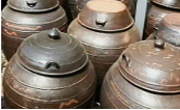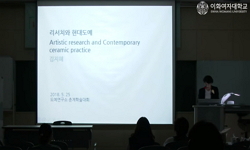There have been many changes and achievements in the short period of time until the formation of modern Korean ceramic art. Considering the beginning of modern ceramic art in Korea from the mid-1950s to the 1960s, the establishment of the Ministry of ...
http://chineseinput.net/에서 pinyin(병음)방식으로 중국어를 변환할 수 있습니다.
변환된 중국어를 복사하여 사용하시면 됩니다.
- 中文 을 입력하시려면 zhongwen을 입력하시고 space를누르시면됩니다.
- 北京 을 입력하시려면 beijing을 입력하시고 space를 누르시면 됩니다.

현대도예가 김석환의 삶과 작품세계 연구 = A Study on the Life and Works of Kim Seok-hwan, a modern ceramic artist
한글로보기https://www.riss.kr/link?id=A107152460
- 저자
- 발행기관
- 학술지명
- 권호사항
-
발행연도
2020
-
작성언어
Korean
-
주제어
Seokhwan Kim ; Modern Ceramics ; Onggi ; Ceramics Education ; DolSeok Ceramics Museum ; 김석환 ; 현대도예 ; 옹기 ; 도예교육 ; 돌석도예박물관
-
등재정보
KCI등재후보
-
자료형태
학술저널
-
수록면
105-120(16쪽)
-
KCI 피인용횟수
0
- DOI식별코드
- 제공처
- 소장기관
-
0
상세조회 -
0
다운로드
부가정보
다국어 초록 (Multilingual Abstract)
There have been many changes and achievements in the short period of time until the formation of modern Korean ceramic art.
Considering the beginning of modern ceramic art in Korea from the mid-1950s to the 1960s, the establishment of the Ministry of Crafts and Crafts in Korea and the formal and active pottery education at the university can be said to be a full-fledged departure. In 1958, the Korean Craft Demonstration Center was established with the support of the US CIA, and this demonstration site was used as a training place for students at Seoul National University and Hongik University. Became. At this time, Seok-Hwan Kim, a student at Hongik University, was Mrs. Seok-Hwan Kim, who is covered in this study, is the first generation of modern ceramic art and has produced a lot of disciples through his pottery education throughout his life, and has made many achievements with his vigorous work activities and ceramic works. The potter's pottery, which began in the late 1950s, was the first in the ceramics division to win a national exhibition, and then, during the education of post-secondary education, he had an active solo exhibition. The teacher's work expresses abstract and modern patterns with traditional elements in the early stages, and then shows the trend of large-scale work using a wheel.also trained by Stanley Fistic of the Korean Craft Demonstration Center. To establish itself as.
It is the most Korean, traditional, and interested in Onggi, which naturally expresses the physical properties of the soil. The huge work with the motif of Onggi is a work designed with a modern sense by sublimating traditional elements and techniques such as oil-free and salt oil. These works are stored in the 'Dol Seok Ceramics Museum', which the teacher spent at the expense of his life and prepared at the foot of Surisan. The museum can also be said to be a valuable work in which the works of the teacher's life are concentrated.
국문 초록 (Abstract)
지금의 한국 현대도예가 형성되기까지 짧은 기간 동안 많은 변화와 성과가 있었다. 우리나라 현대도예의 시작을 1950년대 중반 이후부터 1960년대로 간주할 때, 국전 공예부의 창설과 함께 대...
지금의 한국 현대도예가 형성되기까지 짧은 기간 동안 많은 변화와 성과가 있었다.
우리나라 현대도예의 시작을 1950년대 중반 이후부터 1960년대로 간주할 때, 국전 공예부의 창설과 함께 대학에서 정식으로 활발하게 이뤄진 도예교육을 본격적인 출발이라 할 수 있다. 1958년에는 미국 CIA의 지원으로 한국공예시범소 가 설립되었고 이 시범소는 서울대와 홍익대 학생들의 실습장소로 활용되며 이전까지 일본의 영향을 받던 우리나라 도자문화가 미국도예의 영향을 받게 되는 결정적인 계기가 되었다. 이때 홍익대에 재학하던 김석환 선생도 한국공예시범소의 스탠리 피스틱(Stanley Fistic)의 교육을 받았으며 이처럼 대학교육과 해외유학을 통해 교육을 받은 작가들이 한국 현대도예를 태동하고 형성해 가는 우리나라 현대도예의 1세대로 자리매김하게 된다.
본 연구에서 다루고 있는 김석환 선생은 현대도예의 1세대로서 평생을 도예교육을 통해 많은 제자를 배출하였고, 왕성한 작품활동과 도예작품으로 많은 업적을 남겼다. 1950년대 후반부터 시작된 선생의 도예는 도자부문에서는 처음으로 국전에서 입선을 하고 이어서 후학을 교육하는 와중에도 활발한 개인전을 갖게된다. 선생의 작업은 초기에 추상적이고 현대적인 문양을 전통적인 요소와 응용하여 표현하였고 이후 물레를 이용한 대형화된 작품경향을 보인다. 가장 한국적이고 전통적이며 흙의 물성이 자연스럽게 표현된 옹기에도 관심이 많아 많은 수집은 물론이거니와 작품의 곳곳에 표현되어 있는 것을 볼 수 있다. 옹기를 모티브로 한 거대한 작업은 무유소성과 소금유 등 전통적인 요소와 기법을 승화시켜 현대적 감각으로 디자인된 작품이라 할 수 있다. 이러한 작품들은 선생이 생전에 사비를 들여서 수리산 자락에 마련한 ‘돌석도예박물관’에 소장되어 있다. 박물관 역시 선생의 생애의 작업들이 집약된 귀중한 유작이라 할 수 있다.
참고문헌 (Reference)
1 Clark, Garth, "현대도예의 탄생·예술가들" 서울문화 2012
2 김수진, "현대도예의 전개양상 고찰을 통한 조형적 특성 연구 : 한국과 미국을 중심으로" 이화여자대학교 대학원 2008
3 강재영, "현대도예의 장르 해체 경향에 관한 연구 : 알레고리를 중심으로" 홍익대학교 대학원 2007
4 신상호, "현대도예 : 미래를 향한 움직임 = Contemporary ceramics" 홍익대학교도예연구소 1993
5 박선우, "한국현대도예의 성립과 사회적 영향" 한국디자인트렌드학회 (12) : 313-324, 2005
6 최공호, "한국현대공예사의 이해" 재원 1996
7 곽태영, "한국 현대도예의 성립에 관한 연구 - 근대성을 중심으로" 한국기초조형학회 5 (5): 365-373, 2004
8 "제 1회 김석환 도예전"
9 "재미있는 얼굴전"
10 허보윤, "새로운 과거 : 박물관 유물과 현대 도자공예" 서울대학교박물관 2013
1 Clark, Garth, "현대도예의 탄생·예술가들" 서울문화 2012
2 김수진, "현대도예의 전개양상 고찰을 통한 조형적 특성 연구 : 한국과 미국을 중심으로" 이화여자대학교 대학원 2008
3 강재영, "현대도예의 장르 해체 경향에 관한 연구 : 알레고리를 중심으로" 홍익대학교 대학원 2007
4 신상호, "현대도예 : 미래를 향한 움직임 = Contemporary ceramics" 홍익대학교도예연구소 1993
5 박선우, "한국현대도예의 성립과 사회적 영향" 한국디자인트렌드학회 (12) : 313-324, 2005
6 최공호, "한국현대공예사의 이해" 재원 1996
7 곽태영, "한국 현대도예의 성립에 관한 연구 - 근대성을 중심으로" 한국기초조형학회 5 (5): 365-373, 2004
8 "제 1회 김석환 도예전"
9 "재미있는 얼굴전"
10 허보윤, "새로운 과거 : 박물관 유물과 현대 도자공예" 서울대학교박물관 2013
11 "김석환 도예전"
12 "김석환 도예전"
13 "김석환 도예전"
14 "김석환 개인전"
15 "김석환 개인전"
동일학술지(권/호) 다른 논문
-
- 한국도자학회
- 한국도자학회
- 2020
- KCI등재후보
-
- 한국도자학회
- 민세원
- 2020
- KCI등재후보
-
Study on Contemporary Ceramics under the context of Globalization through Structuralism
- 한국도자학회
- Gao, Xue-Wen
- 2020
- KCI등재후보
-
- 한국도자학회
- 손지웅
- 2020
- KCI등재후보
분석정보
인용정보 인용지수 설명보기
학술지 이력
| 연월일 | 이력구분 | 이력상세 | 등재구분 |
|---|---|---|---|
| 2022 | 평가예정 | 계속평가 신청대상 (계속평가) | |
| 2020-01-01 | 평가 | 등재후보학술지 선정 (신규평가) |  |
| 2019-12-01 | 평가 | 등재후보 탈락 (계속평가) | |
| 2018-12-01 | 평가 | 등재후보로 하락 (계속평가) |  |
| 2015-01-01 | 평가 | 등재학술지 선정 (계속평가) |  |
| 2013-01-01 | 평가 | 등재후보학술지 유지 (기타) |  |
| 2012-01-01 | 평가 | 등재후보학술지 유지 (기타) |  |
| 2011-01-01 | 평가 | 등재후보 1차 FAIL (등재후보1차) |  |
| 2010-01-01 | 평가 | 등재후보 1차 PASS (등재후보1차) |  |
| 2008-01-01 | 평가 | 등재후보학술지 선정 (신규평가) |  |
학술지 인용정보
| 기준연도 | WOS-KCI 통합IF(2년) | KCIF(2년) | KCIF(3년) |
|---|---|---|---|
| 2016 | 0.07 | 0.07 | 0.09 |
| KCIF(4년) | KCIF(5년) | 중심성지수(3년) | 즉시성지수 |
| 0.13 | 0.13 | 0.283 | 0.16 |




 KCI
KCI eArticle
eArticle





